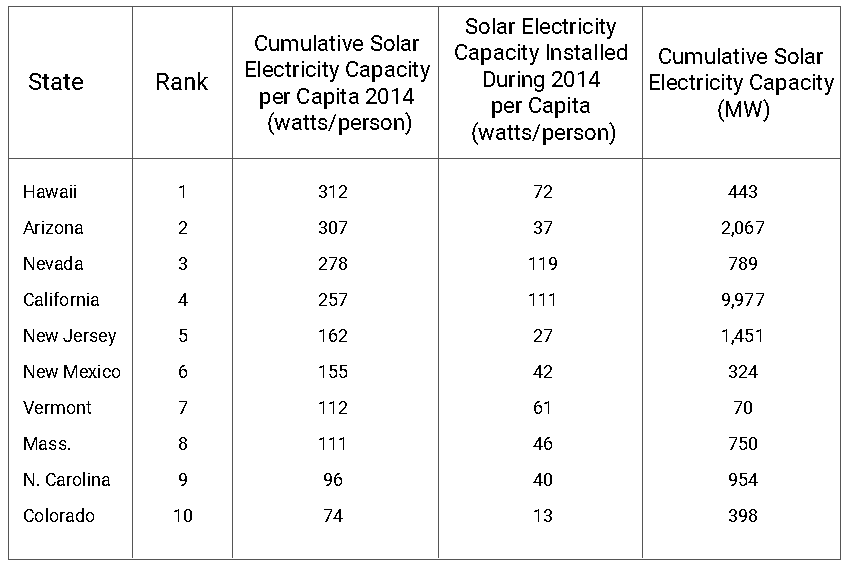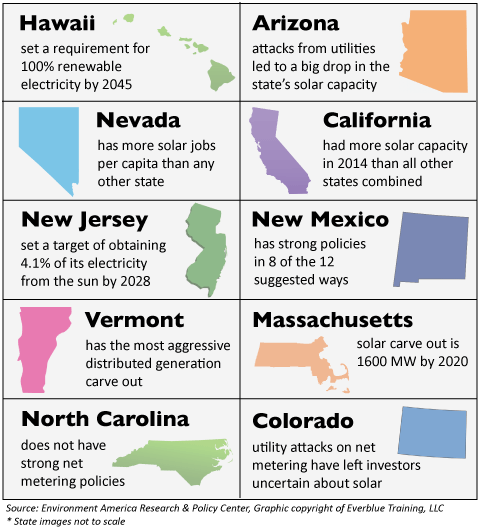No products in the cart.
Top 10 States for Solar Energy
In-depth research from the Frontier Group was released last week regarding the top states that helped drive America’s solar energy boom in 2014. The report, which is the third annual of its kind, analyzes the policies in each of the top states and explains why these programs helped to grow the solar energy industry.
If you support solar energy and know that you’re ready to begin working in the solar industry, set your sights on a career in solar installation. Our Solar Overview section will put you on the path of adding solar to your business skill sets.
In this post, we’re going to summarize the main points that we took away from the research. We certainly would like to thank Gideon Weissman of the Frontier Group and Rob Sargent from Environment America Research & Policy Center for their time putting together this incredible report. The analysis includes a lot of great information, key insights, and recommendations for future growth. If you’re interested in reading the 46-page report, you may do so by clicking here. Without further ado, let’s take a look at the important takeaways from the report.
A Look at the Policies that Led to Their Success
The top 10 states with the most solar electricity installed per capita account for only 26% of the U.S. population but 86% of the nation’s total installed solar electricity capacity.
As ranked by cumulative capacity per resident, the top 10 states for solar are:

As you can see, the states reaping the largest benefits from the growth of solar energy are not necessarily those with the most sunshine. Rather, they are the states that have laid the policy groundwork to encourage solar energy adoption. In the small eastern states (New Jersey, Massachusetts, and Vermont), sunlight is less abundant — but grid electricity prices are high, and public concern about pollution has led to strong support for clean local energy.
The key takeaway from the Frontier Group’s research is this: The most important determinant of a successful solar energy market is the degree to which state and local governments have recognized the benefits of solar energy and created a fertile public policy atmosphere for the development of the solar industry. A recent study by the U.S. Department of Energy’s National Renewable Energy Laboratory confirmed that renewable portfolio standards, provisions for third-party ownership, and net metering and interconnection standards are important indicators of state solar capacity.
There are three types of policies that should be in place to best build a strong market for solar energy.
Market Preparation Policies
— make it possible for homeowners and businesses to “go solar”
- Interconnection Standards: clarify how and under what conditions utilities must connect solar panels to the grid. The process may be complex and/or expensive, which can be a significant barrier to bringing a solar energy system online. Ways to fix the interconnection process include clearly identifying fees associated with the process, specifying timelines, and standardizing and simplifying forms.
- Net Metering: allows people to generate their own electricity, export any excess electricity to the grid, and get paid for providing this excess energy to the utility
- Feed-in Tariffs: a cost-based price for the renewable electricity a consumer or business supplies to the grid. The tariff (or rate) may differ by technology, location (e.g. rooftop or ground-mounted for solar PV projects), size (residential or commercial scale), and region. The feed-in tariff provides support for solar in states or localities where net metering policies are weak or do not exist.
- Solar Rights Policies: override local ordinances or homeowners’ association policies that bar citizens from installing solar energy equipment on their properties
- Utility Rate Structures: state utility regulators develop and approve utility rate structures that have a major impact on the financial desirability of solar energy. For example, rate structures that have a higher ratio of per-kilowatt-hour to per-customer charges will tend to encourage solar energy by ensuring that customers receive the maximum benefit for reducing their consumption of electricity from the grid, especially during peak times.
- Smart Permitting and Zoning Rules: can eliminate unnecessary obstacles to solar development. The cost of permitting, interconnection, and inspection of solar energy systems represents about 3% of the cost of a residential solar energy system. State policies can set reasonable limits on the permitting practices of local governments.
- Building Codes: either local or statewide, can require new homes and commercial establishments to be built “solar ready” or to meet standards for energy consumption (such as “zero net energy” standards) that encourage the use of solar or other renewable energy technologies
Market Creation Policies
— create the conditions for businesses to begin marketing solar energy to individuals and commercial facility owners
- Renewable Electricity Standards (RESs) or Renewable Portfolio Standards (RPSs): set minimum renewable energy requirements for utilities. These generally place an obligation on electricity supply companies to produce a specified fraction of their electricity from renewable energy sources.
- RESs with a Solar Carve Out: a specific minimum requirement for solar energy. Solar carve outs require a certain percentage of the RESs be met with solar energy.
Market Expansion Policies
— bring solar energy within the reach of those who might not otherwise have access to the technology due to financial restrictions or other impediments
- Grants, Rebates, Tax Incentives, and Loans: are among the many financial incentives that help reduce the cost of solar energy
- Declining Megawatt Block Programs: long-term rebate programs that reduce and ultimately phase out rebates as increasing amounts of solar energy are added to the grid. Incentive rates are designed to decrease as more people go solar.
- Solar Leasing: a third-party company installs, owns, and maintains the solar panels but leases them to the consumer on whose property they generate power. Consumers may make the lease payment upfront or make payments over time. The consumer benefits from lower electricity consumption from the grid and from net metering credits on their electricity bill; the third-party benefits from lease payments and by claiming the value of financial incentives and tax credits.
- Third-Party Ownership: similar to a solar lease, except the third-party retains ownership over the electricity produced by the solar panels, selling that electricity to the consumer at a fixed price. The consumer does not pay for the solar panels – only purchases the electricity they produce.
- PACE Financing: Property Assessed Clean Energy is a means of financing energy efficiency upgrades or renewable energy installations for buildings and eliminates concern over upfront costs. PACE financing enables consumers to pay back the cost of solar energy systems over time on their property tax bills. PACE financing not only spreads the cost of solar energy over time, but by tying responsibility for repayment to the property — not the owner of the property — it ensures that a consumer will receive savings even if he or she must move in a few years.
- Virtual Net Metering: customers can receive net metering credits for projects even if they are not connected to their property. It allows renters and other non-homeowners to invest in energy projects.
- Aggregated Net Metering: allows a single utility customer (usually a commercial or government entity) to apply net metering credits to multiple buildings that it owns
- Lead-by-example Policies: expand solar markets by requiring government agencies to consider or install solar energy on public buildings
The leading states for solar have adopted strong policies of their own in all three categories, and all of the top 10 states also have solar rights laws that protect the individual homeowner’s right to “go solar.”
Fun Facts About the Top 10 Solar States
